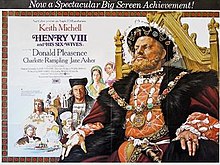Plot
On his deathbed, Henry VIII reflects upon his long reign, and especially the crucial part his six marriages have played. The bulk of the film is depicted in flashback, while the dying Henry is surrounded by his family and courtiers.
Henry's first queen is the Spanish princess Catherine of Aragon. The young pair are in the midst of celebrating the birth of their son, only to be told that he has died. Henry and Catherine mourn their child together, and hope for another soon. Many years pass, during which time Catherine only produces one living daughter, Mary. Henry confides to Thomas More that he fears the marriage is cursed by God, as Catherine was previously wed to Henry's late older brother, Arthur, although Catherine proclaimed the marriage was not consummated.
Henry woos Anne Boleyn, a lady at court, who refuses to sleep with him unless she is his wife. Henry presses the Vatican to annul his marriage to Catherine. When that fails, he has Cardinal Wolsey removed from office and himself made head of the new Church of England. The marriage annulled, Catherine is sent away from court, and Anne is crowned the new queen. Anne also fails to produce a male heir, giving birth to a daughter, Elizabeth. Henry loses interest in Anne and starts courting Jane Seymour, another lady of the court. Thomas Cromwell, protégé of Cardinal Wolsey, observes Henry's interest in Jane and assists him by presenting a false case of Anne's infidelity with various men of the court, including her own brother, George Boleyn. Anne is beheaded in the Tower of London.
Henry marries Jane Seymour, who successfully returns Princess Mary to royal favour and has opinions on the matter of religion, asking for pardons for the participants of the Pilgrimage of Grace. Jane gives birth to Henry's long-sought male heir, Edward, but she dies soon after.
Henry's courtiers advise him to marry again for diplomatic reasons, with Cromwell pushing for the German Anne of Cleves, of whose portrait Henry approves. However, when she arrives Henry is disappointed that her appearance does not match the image. After a reluctant wedding, he arranges an annulment.
At court, Henry is drawn to Catherine Howard, young cousin of Anne Boleyn. Catherine is flattered by Henry's attention. Her uncle, Thomas Howard, Duke of Norfolk, urges her to return his affections. Henry and Catherine marry, with Henry lavishing her with many gifts and jewels. Archbishop Thomas Cranmer discovers that Catherine has had liaisons before her marriage, and presents this knowledge to Henry, who initially disbelieves the charges. Cranmer secures a confession from Catherine, who also admits an affair with Thomas Culpeper during her marriage to Henry. Catherine is beheaded.
Henry, now elderly, approaches Catherine Parr, a widow from two previous marriages. Catherine is reluctant, citing her religious views which differ from Henry's, but Henry admits his need for companionship in his old age. The pair marry, and Catherine becomes a loving stepmother to the royal children Mary, Elizabeth, and Edward.
At the end of the flashbacks, Catherine Parr is shown waiting by Henry's beside with Princess Mary. Archbishop Cranmer is summoned for Henry's final confession, and Henry dies holding his hand.

Henry VIII was King of England from 22 April 1509 until his death in 1547. Henry is known for his six marriages and his efforts to have his first marriage annulled. His disagreement with Pope Clement VII about such an annulment led Henry to initiate the English Reformation, separating the Church of England from papal authority. He appointed himself Supreme Head of the Church of England and dissolved convents and monasteries, for which he was excommunicated by the pope.

The House of Tudor was an English and Welsh dynasty that held the throne of England from 1485 to 1603. They descended from the Tudors of Penmynydd, a Welsh noble family, and Catherine of Valois. The Tudor monarchs ruled the Kingdom of England and the Lordship of Ireland for 118 years with five monarchs: Henry VII, Henry VIII, Edward VI, Mary I and Elizabeth I. The Tudors succeeded the House of Plantagenet as rulers of the Kingdom of England, and were succeeded by the House of Stuart. The first Tudor monarch, Henry VII, descended through his mother from the House of Beaufort, a legitimised branch of the English royal House of Lancaster, a cadet house of the Plantagenets. The Tudor family rose to power and started the Tudor period in the wake of the Wars of the Roses (1455–1487), which left the main House of Lancaster extinct in the male line.

Anne Boleyn was Queen of England from 1533 to 1536, as the second wife of King Henry VIII. The circumstances of her marriage and of her execution by beheading for treason and other charges made her a key figure in the political and religious upheaval that marked the start of the English Reformation.

Anne of the Thousand Days is a 1969 British historical drama film based on the life of Anne Boleyn, directed by Charles Jarrott and produced by Hal B. Wallis. The screenplay by Bridget Boland and John Hale is an adaptation of the 1948 play of the same name by Maxwell Anderson.
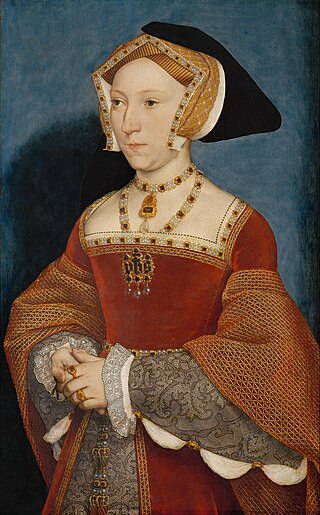
Jane Seymour was Queen of England as the third wife of King Henry VIII from their marriage on 30 May 1536 until her death the next year. She became queen following the execution of Henry's second wife, Anne Boleyn, who was accused by King Henry VIII of adultery after failing to produce the male heir he so desperately desired. Jane, however, died of postnatal complications less than two weeks after the birth of her only child, the future King Edward VI. She was the only wife of Henry to receive a queen's funeral; and he was later buried alongside her remains in St George's Chapel, Windsor Castle.
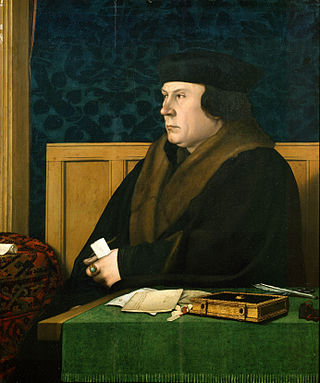
Thomas Cromwell, briefly Earl of Essex, was an English statesman and lawyer who served as chief minister to King Henry VIII from 1534 to 1540, when he was beheaded on orders of the king, who later blamed false charges for the execution.
The Private Life of Henry VIII is a 1933 British film directed and co-produced by Alexander Korda and starring Charles Laughton, Robert Donat, Merle Oberon and Elsa Lanchester. It was written by Lajos Bíró and Arthur Wimperis for London Film Productions, Korda's production company. The film, which focuses on the marriages of King Henry VIII of England, was a major international success, establishing Korda as a leading filmmaker and Laughton as a box-office star.
The Six Wives of Henry VIII is a series of six television plays produced by the BBC and first transmitted between 1 January and 5 February 1970. The series later aired in the United States on CBS from 1 August to 5 September 1971 with narration added by Anthony Quayle. The series was rebroadcast in the United States without commercials on PBS as part of its Masterpiece Theatre series.
Jane Boleyn, Viscountess Rochford was an English noblewoman. Her husband, George Boleyn, Viscount Rochford, was the brother of Anne Boleyn, the second wife of King Henry VIII. Jane had been a member of the household of Henry's first wife, Catherine of Aragon. It is possible that she played a role in the verdicts against, and subsequent executions of, her husband and Anne Boleyn. She was later a lady-in-waiting to Henry's third and fourth wives, and then to his fifth wife, Catherine Howard, with whom she was executed.

Thomas Howard, 3rd Duke of Norfolk, was a prominent English politician and nobleman of the Tudor era. He was an uncle of two of the wives of King Henry VIII, Anne Boleyn and Catherine Howard, both of whom were beheaded, and played a major role in the machinations affecting these royal marriages. After falling from favour in 1546, he was stripped of his dukedom and imprisoned in the Tower of London, avoiding execution when Henry VIII died on 28 January 1547.
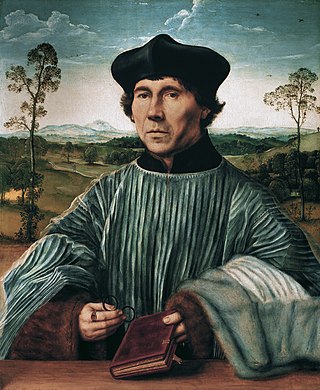
Stephen Gardiner was an English Catholic bishop and politician during the English Reformation period who served as Lord Chancellor during the reign of Queen Mary I and King Philip.

In common parlance, the wives of Henry VIII were the six queens consort of King Henry VIII of England between 1509 and his death in 1547. In legal terms, Henry had only three wives, because three of his marriages were annulled by the Church of England. However, he was never granted an annulment by the Pope, as he desired, for Catherine of Aragon, his first wife. Annulments declare that a true marriage never took place, unlike a divorce, in which a married couple end their union. Along with his six wives, Henry took several mistresses.

The Boleyn Inheritance is a novel by British author Philippa Gregory which was first published in 2006. It is a direct sequel to her previous novel The Other Boleyn Girl, and one of the additions to her six-part series on the Tudor royals. * The novel is told through the first-person narratives of – Anne of Cleves, Katherine Howard, and Jane Boleyn, who was mentioned in The Other Boleyn Girl. It covers a period from 1539 until 1542 and chronicles the fourth and fifth marriages of King Henry VIII of England.
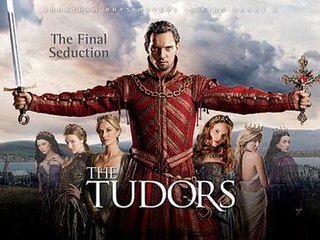
The Tudors is a historical fiction television series set primarily in 16th-century England, created and written by Michael Hirst and produced for the American premium cable television channel Showtime. The series was a collaboration among American, British, and Canadian producers, and was filmed mostly in Ireland. While named after the Tudor dynasty as a whole, it is based specifically upon the reign of King Henry VIII.

Henry VIII is a two-part British television serial produced principally by Granada Television for ITV from 12 to 19 October 2003. It chronicles the life of Henry VIII of England from the disintegration of his first marriage to an aging Spanish princess until his death following a stroke in 1547, by which time he had married for the sixth time. Additional production funding was provided by WGBH Boston, Powercorp and the Australian Broadcasting Corporation.

The Six Wives of Henry VIII is a 2001 television documentary series about the wives of King Henry VIII presented by historian David Starkey from historic locations with added re-enactments.
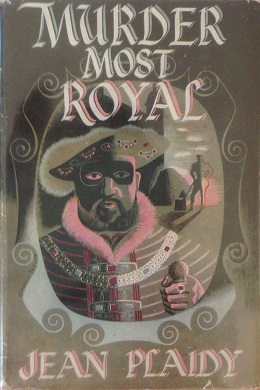
Murder Most Royal (1949) is an historical fiction novel by Jean Plaidy.
Anne Berkeley, Baroness Berkeley was a lady-in-waiting and companion of Queen Anne Boleyn, the second wife of Henry VIII of England. She was reputed to be one of the witnesses at the secret wedding ceremony of the King and Anne Boleyn which occurred on 25 January 1533.

Catherine Howard, also spelt Katheryn Howard, was Queen of England from 1540 until 1541 as the fifth wife of King Henry VIII. She was the daughter of Lord Edmund Howard and Joyce Culpeper, a cousin to Anne Boleyn, and the niece of Thomas Howard, 3rd Duke of Norfolk. Thomas Howard was a prominent politician at Henry's court, and he secured her a place in the household of Henry's fourth wife, Anne of Cleves, where she caught the King's interest. She married him on 28 July 1540 at Oatlands Palace in Surrey, just 19 days after the annulment of his marriage to Anne. He was 49, and she was between 15 and 21 years old, though it is widely accepted that she was 17 at the time of her marriage to Henry VIII.
Anne Boleyn is a play on the life of Anne Boleyn by the English author Howard Brenton, which premiered at Shakespeare's Globe in 2010. Anne Boleyn is portrayed as a significant force in the political and religious in-fighting at court and a furtherer of the cause of Protestantism in her enthusiasm for the Tyndale Bible.
